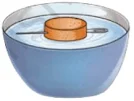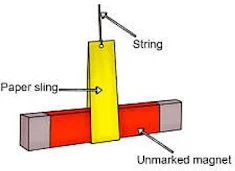Chapter 4 Exploring Magnets Revision Notes Class 6 Science
Exploring Magnets Chapter Notes Class 6
- Introduction
- Magnetic and Non-magnetic Materials
- Poles of a Magnet
- Finding Directions using a Magnet
- Attraction and Repulsion between Magnets
- Fun with Magnets
- Keywords
Introduction
Magnets are objects that can attract materials like iron, cobalt, and nickel. They have been used for centuries, with sailors in ancient times relying on magnetic compasses to navigate their ships. They are used in various applications, from compasses to electronics.
- Magnets can be natural, such as lodestones, or artificial, made from materials like iron or other metals.
- Magnets come in different shapes and sizes, serving various purposes in our daily lives, from keeping things closed to helping us find directions.
Magnetic and Non-magnetic Materials
- Magnetic Materials: These are materials that are attracted to magnets (e.g., iron, nickel, cobalt).
- Non-Magnetic Materials: These materials are not attracted to magnets (e.g., plastic, wood, glass).
Magnetic vs. Non-Magnetic Materials
- Magnetic materials have properties that allow them to be influenced by a magnet's force, while non- magnetic materials do not interact with magnets.
Poles of a Magnet
The magnetic force is strongest at these poles. If you were to sprinkle iron filings around a bar magnet, you would notice that the filings gather more densely at the ends of the magnet, indicating the location of the poles.
- Every magnet has two poles: a North Pole and a South Pole.
- It is impossible to get a magnet with only one pole. Even if you break a magnet into smaller pieces, each piece will still have both a North and a South pole. A single North pole or South pole cannot exist on its own.

Attraction: Unlike poles (North-South) attract each other.
Repulsion: Like poles (North-North or South-South) repel each other.
Finding directions using a Magnet
Magnets have a special property that makes them extremely useful for finding directions. This property has been known and used by sailors and travellers for many years.
Freely Suspended Magnet

When a magnet is freely suspended, it naturally settles in the north-south direction. The end of the magnet that points toward the north is called the North-seeking pole or the North pole, while the end that points toward the south is known as the South-seeking pole or the South pole.
- This happens because the Earth itself acts like a giant magnet with a magnetic field. The ability of a freely suspended magnet to always align itself in the north-south direction is used to determine directions.
How It Works?
- Suspending the Magnet: To observe this property, you can take a bar magnet and suspend it from a thread. Ensure the magnet is hanging freely and can rotate without any obstruction.
- Alignment: Once the magnet comes to rest, it will align itself in the north-south direction. If you rotate the magnet and let it go, it will again come to rest pointing north-south.
Magnetic Compass
A long time ago, a small device called a magnetic compass was created to help people find directions. The compass contains a needle-shaped magnet that can rotate freely. This needle always points in the north-south direction.

How to Use a Magnetic Compass
- To use the compass, place it where you want to determine the directions. After a short while, the needle will settle in the north-south direction.
- You then gently rotate the compass box until the "north" and "south" markings on the dial match the needle's position. Once aligned, the dial will show all the directions at that location.
Structure of a Magnetic Compass
- A magnetic compass is typically a small circular box with a clear cover. Inside the box, there is a needle-shaped magnet placed on a pin that stands at the bottom. This needle is balanced on the pin in such a way that it can easily rotate or move freely around this point.
- The end of the needle that points toward the North is usually painted red. Beneath the needle, there is a dial with directions marked on it.
Making a Simple Compass
You can make a simple compass at home using a sewing needle, a cork, and a bowl of water.
Step 1: Magnetizing the Needle: Stroke a sewing needle several times with a magnet to magnetize it.
Step 2: Preparing the Cork: Push the needle through a small piece of cork so that it floats.

Ancient Indian Navigation Tool: Matsya-Yantra
- Long before the modern magnetic compass became widely used, Indians used a similar device for sea navigation. This device was known as the Matsya-Yantra (or Machchh-Yantra).
- It consisted of a fish-shaped piece of magnetized iron, which was placed in a vessel filled with oil. Like the compass needle, it helped in finding directions.
Comparison between a Freely suspended Magnet and a Magnetic Compass

- Freely Suspended Magnet: When you hang a bar magnet by a thread, it automatically aligns itself along the north-south direction. This happens because Earth itself acts like a giant magnet, and the magnet you're using is attracted to the Earth's magnetic poles.
- Magnetic Compass: A magnetic compass has a small needle that is also a magnet. This needle can rotate freely and will always point in the north-south direction when it comes to rest, just like the freely suspended magnet.
- Freely Suspended Magnet: This setup is more of a learning tool or a basic experiment to show magnetic properties. It's not something you would carry around to find directions.
- Magnetic Compass: This is a portable device that you can carry with you to find directions anywhere, like when you're hiking or exploring.
- Freely Suspended Magnet: It hangs still unless you move it, and when you do, it takes some time to settle back into the north-south direction.
- Magnetic Compass: The needle in the compass moves quickly and smoothly to point north, making it easy to find your direction in a short time.
Application of Magnets in Daily Life
- Magnetic Garlands: Used in decorations, such as hanging items in a creative display.
- Magnetic Mazes: Used in games where steel balls are guided through a maze using magnets.
- Steel Paper Clip from Water: A steel paper clip can be lifted from water using a magnet without getting your fingers or the magnet wet.
- Magnetic Effects in Experiments: Demonstrating how magnetic fields can influence other objects without direct contact.
Identifying the Poles of a Magnet

- In some magnets, the North and South poles are labeled with the letters "N" and "S."
- In other magnets, a white dot is used to indicate the North pole.
- Sometimes, the North pole is painted red, and the South pole is painted blue to make it easier to identify them.
How to keep the magnets safe?
To keep magnets safe, follow these guidelines:
- Proper Storage: Store magnets in pairs, with opposite poles (unlike poles) on the same side. Place a piece of wood between them, and add two pieces of soft iron across the ends.
- Avoid Damage: Don't heat, drop, or hammer magnets, as this can weaken them.
- Keep Away from Electronics: Avoid placing magnets near mobile phones, remote controls, or other electronic devices to prevent interference.
Keywords
- Attraction: The force that pulls magnetic materials (like iron) towards a magnet. Unlike poles (North-South) attract each other.
- Repulsion: The force that pushes similar poles (North-North or South-South) of two magnets away from each other.
- Magnet: An object that produces a magnetic field and can attract magnetic materials like iron, nickel, and cobalt.
- Magnetic Materials: Materials that are attracted by magnets (e.g., iron, nickel, cobalt).
- Non-Magnetic Materials: Materials that are not attracted by magnets (e.g., plastic, wood, glass).
- Poles of a Magnet: The two ends of a magnet where the magnetic force is strongest. These are called the North (N) and South (S) poles.
- Magnetic Compass: A device used to find directions. It has a magnetic needle that aligns itself with the Earth's magnetic field, pointing towards the north-south direction.
- Bar Magnet: A straight, rectangular-shaped magnet with two poles (North and South) at the ends.
- Ring Magnet: A magnet in the shape of a ring, with the North and South poles located on opposite faces of the ring.
- U-shaped Magnet: A magnet that is bent into the shape of a "U," with poles at the ends of the two arms. It is often stronger due to the closer proximity of the poles.
- Magnetic Field: The invisible area around a magnet where its magnetic forces can be felt.
- Lodestone: A naturally occurring magnetic rock that was used in ancient time as a compass to find directions.
- Magnetic Induction: The process of making a material (like iron) magnetic by bringing it close to a magnet or rubbing it with a magnet.
- North Pole: One of the two poles of a magnet that points towards the Earth's geographic North when the magnet is freely suspended.
- South Pole: The opposite pole of a magnet that points towards the Earth's geographic South when the magnet is freely suspended.
- Maglev (Magnetic Levitation): A technology where magnets are used to lift and propel objects (like trains) off the ground, reducing friction and allowing high-speed movement.
- Magnetism: The property or ability of a material to attract certain metals like iron, nickel, and cobalt.
- Permanent Magnet: A magnet that retains its magnetic properties for a long time and does not lose its magnetism easily.
- Temporary Magnet: A material that behaves like a magnet when in contact with a permanent magnet but loses its magnetism when the external magnetic field is removed.
- Magnetic Needle: A small, thin magnet (usually found in a compass) that can rotate freely to align with the Earth's magnetic field.


